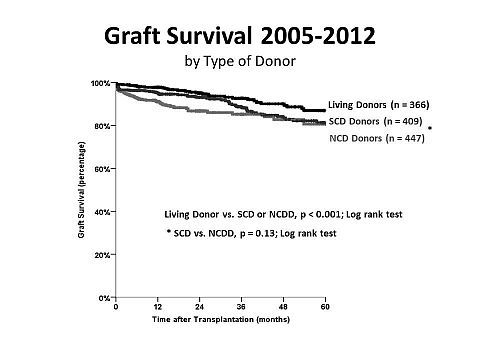Opportunities for Expanding the Deceased Donor Pool in an Era of Outcomes-Driven Health Care
Internal Medicine, Univ of Calif, Davis, Sacramento, CA
Surgery, Univ of Calif, Davis, Sacramento, CA
Meeting: 2013 American Transplant Congress
Abstract number: C1276
Background: The rate of listing of candidates for kidney transplantation continues to exceed the rate of transplantation. In an attempt to narrow this gap the conventional boundaries for deceased donor (DD) kidneys have been pushed. We hypothesized the outcomes for the various non-conventional deceased-donor (NCDD) kidney transplants may have an impact on short term outcomes but acceptable long term outcomes, as compared to standard criteria donors (SCD) and living donors (LD).
Methods: Since 2005 we expanded the DD kidney pool by accepting pediatric-en-bloc donors, expanded criteria donors (ECD), kidneys with acute kidney injury (AKI), donors after circulatory death (DCD), Hep C + donors, and Hep B core Ab + donors. We included all deceased-donor transplants performed between Jan 2005 and July 2012, and evaluated graft and patient survival out to 5 years and e-GFR out to 3 years.
Results: 1222 kidney transplants were performed during the study period (2005-2012) of which 366 were LD, 409 SCD, and 484 NCDD. Of these 151 (31%) were ECD, 151 (31%) DCD, 115 (24%) peds-en-bloc, 120 (25%) AKI, 22 (4.5%) HCV+, and 64 (13%) HepBcAb+ (some fit more than one category). See Table 1.
| 1 Yr Patient Survival | 1 Yr Graft Survival | 5 Yr Patient Survival | 5 Yr Graft Survival | 3 Yr e-GFR | |
| SCD | 99% | 95% | 91% | 82% | 67± |
| ECD | 97% | 88% | 84% | 75% | 52±18.8 |
| DCD | 96% | 91% | 89% | 85% | 66±29.7 |
| Peds-en-Bloc | 96% | 89% | 92% | 87% | 112±40.8 |
| HCV+ | 100% | 96% | 100% | 86% | 60± |
| Hep BcAb+ | 100% | 97% | 92% | 74% | 54±19.9 |
| AKI | 99% | 93% | 89% | 86% | 74±47.2 |
Delayed graft function was noted in 28% of NCDD vs. 13% SCD kidneys (p< 0.001). Graft failure and surgical complications within the first 90 days post-transplant were not significantly different between groups (NCDD vs. SCD). Patient and graft survival (Figure 1) were not statistically different, as compared to SCD.

Conclusions: Expanding the DD pool by utilization of non-conventional donors is an acceptable approach in attempt to decrease the “donor gap”. Short and long-term outcomes are similar to SCD in our center. However, caution is advised before applying our experience to other institutions.
To cite this abstract in AMA style:
Adey D, Perez R, Alnimri M, Mattos ADe. Opportunities for Expanding the Deceased Donor Pool in an Era of Outcomes-Driven Health Care [abstract]. Am J Transplant. 2013; 13 (suppl 5). https://atcmeetingabstracts.com/abstract/opportunities-for-expanding-the-deceased-donor-pool-in-an-era-of-outcomes-driven-health-care/. Accessed December 18, 2025.« Back to 2013 American Transplant Congress
